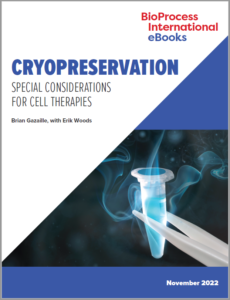eBook: Cryopreservation — Special Considerations for Cell TherapieseBook: Cryopreservation — Special Considerations for Cell Therapies
Sponsored by Savillex
 Freezing is an established approach to maintaining bulk drug substances/products for several biopharmaceutical modalities. Regardless of product type, a cryopreservation process requires extensive testing, monitoring, and control of freezing and thawing conditions. However, because living cells are significantly larger and more complex than monoclonal antibodies (MAbs) and other protein-based biologics, cell therapies raise distinctive concerns for cryopreservation processes. In this eBook, BPI’s managing editor speaks with Erik Wood (cofounder, chief science officer, and senior vice president of Ossium Health) to explore biophysical factors that can complicate cryopreservation of cellular products, specifically adoptive-cell therapies based on hematopoietic progenitor and stem cells (HPCs and HSCs, respectively). Ossium Health recovers such cells from the bone marrow (BM) of recently deceased organ donors. Thus, cryopreservation plays a critical role in the company’s manufacturing process. Herein, Woods describes the characteristics of the cells that his company seeks to isolate and the processes that his team developed to cool, store, and thaw such cells for transplantation.
Freezing is an established approach to maintaining bulk drug substances/products for several biopharmaceutical modalities. Regardless of product type, a cryopreservation process requires extensive testing, monitoring, and control of freezing and thawing conditions. However, because living cells are significantly larger and more complex than monoclonal antibodies (MAbs) and other protein-based biologics, cell therapies raise distinctive concerns for cryopreservation processes. In this eBook, BPI’s managing editor speaks with Erik Wood (cofounder, chief science officer, and senior vice president of Ossium Health) to explore biophysical factors that can complicate cryopreservation of cellular products, specifically adoptive-cell therapies based on hematopoietic progenitor and stem cells (HPCs and HSCs, respectively). Ossium Health recovers such cells from the bone marrow (BM) of recently deceased organ donors. Thus, cryopreservation plays a critical role in the company’s manufacturing process. Herein, Woods describes the characteristics of the cells that his company seeks to isolate and the processes that his team developed to cool, store, and thaw such cells for transplantation.
In addition to providing readers with a cryobiological primer, this eBook calls attention to best practices for freeze–thaw processes and highlight continuing industry needs for scalability, which remains a significant limiting factor in cryopreservation of cell therapies. Read on to learn more.
Fill out the form below to read the complete eBook now.
You May Also Like





